
- SNOW LEOPARD VMDK AND DARWIN SNOW ISO HOW TO
- SNOW LEOPARD VMDK AND DARWIN SNOW ISO FOR MAC
- SNOW LEOPARD VMDK AND DARWIN SNOW ISO INSTALL
- SNOW LEOPARD VMDK AND DARWIN SNOW ISO DRIVER
You should now have a screen similar to the one shown below. Step 5: Now power on the virtual machine and hit “F8” key. Point it to “darwin_snow.iso” which you downloaded in Step 2. Step 4: Click on”Edit virtual machine settings”, select CD/DVD (IDE) option from left hand side and then and select “Use ISO image file” option. Step 3: Start VMware Workstation and open up “Mac 10.6 (experimental).vmx” file which you downloaded in Step 2. Nfs server and file permissions windows 10. You can find them easily elsewhere on the web. Please don’t ask for the link to these files. Step 2: Download pre-made modified version of Snow Leopard.vmdk and darwin_snow.iso files required to get this thing to work.
SNOW LEOPARD VMDK AND DARWIN SNOW ISO INSTALL
Step 1: and install VMware Workstation 7. If you like OS X Snow Leopard, Get a Mac. This guide is for informational purposes only. Of Snow Leopard.vmdk and darwin_snow.iso files.
SNOW LEOPARD VMDK AND DARWIN SNOW ISO HOW TO
How to install OS X Snow Leopard in VMware under Windows 7. FakeSMC causes kernel panics on reboot/shutdown in Snow Leopard in VMware for. Download the VMware image and darwin_snow.iso. Note: We don’t in anyway encourage downloading via file-sharing / torrent sites and run it in an virtualized environment under Windows.Ī pre-made Snow Leopard VMDK.

If you meet all these requirements, you can then install as a VM under Windows and can enjoy the best of both worlds. You’ll need to have a system with an Intel processor which supports hardware virtualization, original OS X retail disk, VMware Workstation 7 and Windows 7, Vista or XP installed as host operating system. Kernel Extensions in backtrace (with dependencies): (1.3)0x55e27000-0x55e67fff dependency: (1.3.0)0x55dbd000 dependency: (2.6)0x55dd9000.The following step by step guide will help you in installing Mac 10.6 as a guest virtual machine in Windows 7. What i must do, please help I am a huge fan of Apple and i want to run Snow Leopard on my system. I also tryed to boot with the following kernel flags but with kernel panics: -x32 -f -x -v and cpus1 -f -x -v.
SNOW LEOPARD VMDK AND DARWIN SNOW ISO DRIVER
Snow Leopard Vmdk And Darwin_Snow 9001 Driver For PlatformĪfter that, I put some kexts i found (i deleted the IOATAFamily.kext) and now i am getting a Kernel Panic: Unable to find driver for platform: ACPI. When i tryed to boot, i got the apple logo screen and the message that i must restart my system with the power button. If for some reasons you are not able to boot into Snow Leopard, try booting with -v and sendout the error message to me on taranfx on twitter. You will have to look around web or perhaps ask taranfx for proper kexts.
SNOW LEOPARD VMDK AND DARWIN SNOW ISO FOR MAC
There are high chances that your sound, ehternet, dont work out of the box thats coz snow leoaprd is made for Mac and not your PC. Open terminal and execute: sudo -s cd VolumesSnowfxSystemLibraryExtensions chown -R root:wheel chmod -R 755. Once you are done that, copy machkernel.test7 and place it in your SNOW partitiondrive root directory. In the patcher for OS options select DarwinMac OS X and for patcher options select Apply DSDT to Snowfx. Then copy the new Extensions Folder and Extensions.mkext from your desktop to Snowf圎xtra.

Navigate to the Extra on Snowfx and delete the old Extensions directory and Extensions.mkext. When done, it creates a new Extensions.mkext on your desktop. Now drag this Extensions folder to Kext Utility app (the one on desktop) to open and repair the permissions of that Extensions Folder. These 7 files are: AppleACPIPS2Nub.kext, fakesmc.kext, NullCPUPowerManagement.kext, OpenHaltRestart.kext, PlatformUUID.kext, VoodooHDA.kext and VoodooPS2Controller.kext.

Now you need to replace the boot file in the root directory of the new partition (Snowfx) with the BOOT file from the i386 folder. When done, make sure the permissions of the partitiondrive are correct by running the following commands in the terminal: sudo -s chown 0:0 VolumesSnowfx. Mount the Snow Leopard.DMG file, then use Disk Utility and save a writeable.DMG file to your desktop.


 0 kommentar(er)
0 kommentar(er)
